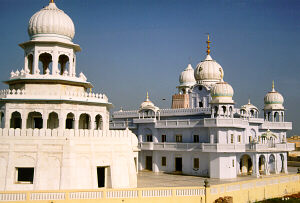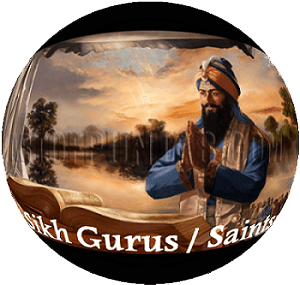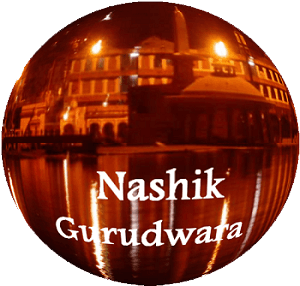Historical Gurdwaras of Punjab - Guru Gobind Singh
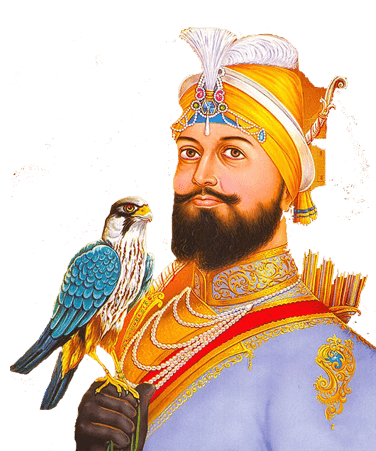
News from Delhi
Gurdwara Patal Puri, Kiratpur, Dist. Ropar
Guru Gobind Singh travelled from here to Anandpur Sahib for the cremation of his fathers head which had been spirited away from Delhi by a devoted Sikh, Bhai Jaita. Guru Hargobind as well as Guru Har Rai were cremated here. The ashes of Guru Har Krishan were brought from Delhi and immersed here in the river Sutlej. In 1675 Guru Gobind Singh at the age of nine received the tragic news that his father Guru Tegh Bahadur had been executed in Delhi.
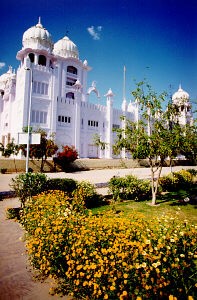
Peace and Poetry
Gurdwara Vibhore Sahib, Dist. Nangal
Guru Gobind Singh stayed here for about a year and composed hymns in praise of God. The Gurdwara is situated on the banks of the river Sutlej. This was among the happiest time of Guru Gobind Singh life when he had time to enjoy hunting and writing poetry in praise of God.
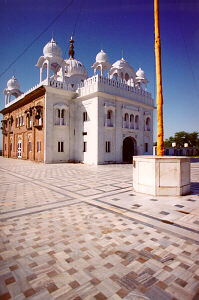
Fortress of Bliss
Qila Anandgarh Sahib, Anandpur Sahib, Dist. Ropar
This Gurdwara was one of the five forts constructed by Guru Gobind Singh at Anandpur Sahib for the defense of the Sikhs. Guru Gobind Singh spent 25 years at Anandpur Sahib. To protect the Sikhs from the hill Rajas or Mughals, Guru Gobind Singh began the construction of five defensive forts all around the town. Keshgarh at the center (now a Takht), Anandgarh (fort of bliss), Lohgarh (fort of steel), Holgarh (fort of colour) and Fatehgarh (fort of victory). All the forts were joined together with earthworks and underground tunnels. The construction began in 1689 and took over ten years to complete.
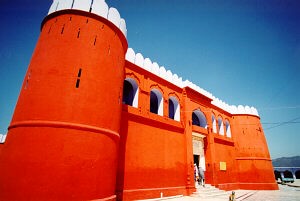
River Crossing
Gurdwara Ghat Sahib, Dist. Nangal
This Gurdwara on the left bank of the river Sutlej marks the spot where Guru Gobind Singh crossed the river by boat from a dock (ghat).
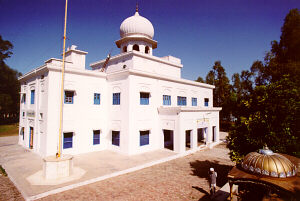
A Brick Kiln
Gurdwara Bhatha Sahib, Dist. Ropar
Guru Gobind Singh visited here and cooled down a red hot brick kiln (bhatha) with the touch of his horses hoof. The local Muslim chief Nihang Khan became a follower of the Guru and at great personal risk looked after the Guru and his Sikhs. At that time anyone helping the Sikhs faced death as punishment from the Mughal authorities.
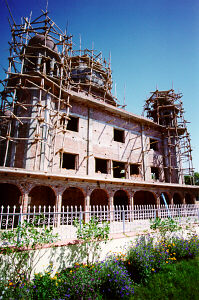
The Gurus Mighty Sword
Gurdwara Bhadaur, Dist. Sangrur
Guru Gobind Singh visited here during one of his hunting expeditions. A sword belonging to Guru Gobind Singh and used in battle is kept here. Guru Gobind Singh introduced a new metaphor for God, Sarbloh meaning All-Steel Mighty Sword.

Baptism of Steel
Takht Sri Keshgarh Sahib, Anandpur Sahib, Dist. Ropar
This is the birthplace of the Khalsa. It was here on March 30th, 1699 that a very large gathering of Sikhs had arrived at Anandpur Sahib as per Guru Gobind Singhs instructions. After prayers Guru Gobind Singh stood up with his sword and asked the gathering of thousands, "Is there anyone here ready to lay down his life at my call? This sword of mine is crying for the blood of a dear Sikh of mine." The congregation was shocked and afraid, the third time Guru Gobind Singh repeated his call, Daya Ram stood up and offered his head. Guru Gobind Singh took him into a tent. The sound of a sword cutting a body was heard and blood trickled out of the tent. Guru Gobind Singh emerged from the tent and asked for another Sikh. Dharam Das stood up and volunteered. Again the same episode was repeated. Three more Sikhs offered their heads to the Guru in the same way, Mukham Chand, Himmat Rai and Sahib Chand. After some time Guru Gobind Singh brought the five Sikhs before the congregation dressed in new clothes and revealed to the congregation that he had really slaughtered five goats inside the tent. Guru Gobind Singh then baptized them with amrit (sweetened water) stirred with his Khanda, The Guru called them his Five Beloved Ones and gave them the last name ‘Singh’ which means Lion. Guru Gobind Singh then humbly bowed before the Five Beloved Ones and asked them to initiate Him into the Khalsa Brotherhood. Never in history has the leader of a religion bowed down before his followers for baptism. Some of the original weapons of Guru Gobind Singh as well as the khanda (two edged sword) used by the Guru to stir the amrit (sweet water) during the Khalsa baptism ceremony are kept here.
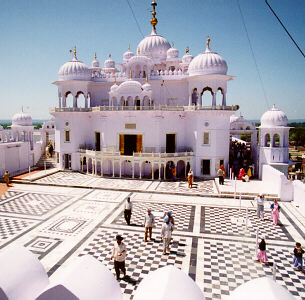
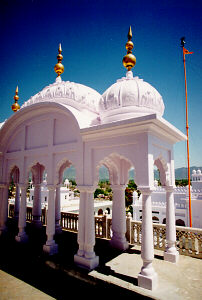
Betrayal of an Oath
Gurdwara Parivar Vichhora, Dist. Ropar
Guru Gobind Singh and 400 Sikhs left Anandpur Sahib on the cold rainy night of December 5th 1705 after a prolonged siege by the Mughal army. The Guru had been offered safe passage if he left the town on a oath on the Koran by emperor Aurangzeb. In the early hours of the morning at the swollen river Sarsa the Guru and his Sikhs were attacked by the Mughal army under the command of Wazir Khan, breaking their oath of safe conduct. In the ensuing confusion, cold and darkness, most of the Sikhs perished. Some braved the current and a few including Guru Gobind Singh were able to cross the river in the heat of the battle. During the confusion the Guru was separated from his family. The Guru, his two eldest sons and 40 Sikhs were able to cross the river and escape. This gurdwara was built on the spot where the battle occurred and the Gurus family was separated.
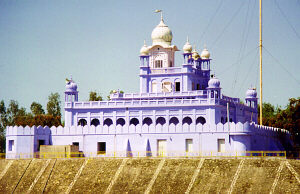
The Final Stand
Gurdwara Garhi Sahib, Chamkaur Sahib, Dist. Ropar
This gurdwara commemorates the spot of the bloody battle of Chamkaur. After the attack at the river Sarsa, Guru Gobind Singh, his two eldest sons and 40 Sikhs made it to the town of Chamkaur while being pursued by an army of 1,000. Guru Gobind Singh and the 40 Sikhs sought shelter in a mud-built double story house. They were attacked by the enemy on December 22, 1705. Against these overwhelming odds, the Sikhs ventured our in small groups to fight the enemy and bravely lay down their lives. Thirty Seven Sikhs were martyred that day including Guru Gobind Singhs two eldest sons as well as three of the Five Beloved Ones (the first baptized Khalsa). Guru Gobind Singh himself was preparing for battle and martyrdom, but the five remaining Sikhs in the fort enacted the scene at Anandpur, where they were had the authority of Guruship and Gobind Singh their Khalsa disciple. Quoting the Gurus words giving them authority to issue resolutions, they ordered Guru Gobind Singh to escape the fort at night followed by three of the five remaining Sikhs.
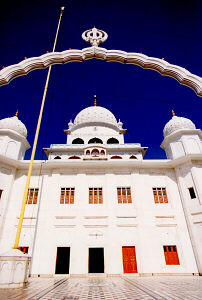
All the Khalsa are My Children
Gurdwara Katalgarh Sahib, Chamkaur Sahib, Dist. Ropar
During the battle of Chamkaur in 1704 in which the Guru and 40 Sikhs fought against overwhelming odds, both of Guru Gobind Singhs sons died in battle at this spot. The remaining Sikhs in the fort at Chamkaur were being martyred one by one, but they did not want the Gurus two sons to go into battle. Guru Gobind Singh declared that all the Sikhs in the fort were his beloved sons. During the battle Baba Ajit Singh asked his fathers permission to go out of the fort and fight the enemy. He said, "Dear father, my name is Ajit or Unconquerable. I will not be conquered. And if conquered, I will not flee or come back alive. Permit me to go, dear father." Guru Gobind Singh hugged and kissed his beloved son before sending him into battle where he fought heroically until his last breath. Baba Jujhar Singh having watched his brother fight, asked Guru Gobind Singh, "Permit me, dear father to go where my brother has gone. Don’t say that I am too young. I am your son, I am a Singh or Lion of yours. I shall prove worthy of you. I shall die fighting, with my face towards the enemy, with God and the Guru on my lips and in my heart." Guru Gobind Singh embraced him and said, "Go my son and wed life-giving Death. We have been here for a while. Now we shall return to our real home. Go and wait for me there. Your grandfather and elder brother are already waiting for you." Thus the Guru watched his two sons achieve eternal peace through martyrdom. Guru Gobind Singh was prepared to follow his sons and Sikhs in martyrdom, but it was not the great Gurus time yet.
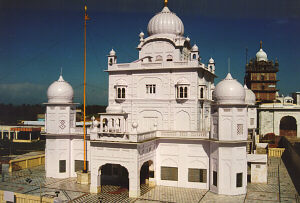
Alone in the Forest
Gurdwara Charan Kanwal, Machhiwara, Dist. Ludhiana
After agreeing to leave Chamkaur as commanded by his Sikhs, Guru Gobind Singh escaped into the night and the jungle surrounded by the enemy troops. In the dark the Guru was separated from his three Sikh and left alone in the dense jungle. Guru Gobind Singh trudged through the jungle day and night, his clothes tattered and his feet blistered. Eventually the Guru reached the outskirts of Machiwara town and lay down to sleep in a garden in some bushes on the ground with a stone as his pillow. Here he was found by the three remaining Sikhs Dharam Singh, Daya Singh and Man Singh. This gurdwara marks that spot where Guru Gobind Singh was found sleeping. Guru Gobind Singh drank water from the well that appears in the foreground.
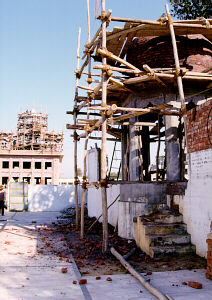
A Nights Refuge
Gurdwara Chubara Sahib, Machhiwara, Dist. Ludhiana
A Sikh named Gulaba Singh lived in the town of Machhiwara and provided Guru Gobind Singh and his three Sikhs refuge in his house at this spot while the enemy where prowling the countryside looking for the Guru with orders to capture or kill him.
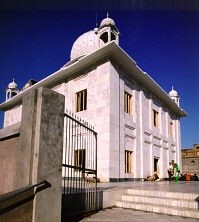
Help from an Unlikely Source
Gurdwara Ghani Khan Nabi Khan, Machhiwara, Dist. Ludhiana
Living in the town of Machhiwara were two Muslim Pathan brothers Ghani Khan and Nabi Khan who knew Guru Gobind Singh. It better times they had sold horses and received kindness from the Guru. Even at the prospect of facing certain death, the brothers agreed to help Guru Gobind Singh escape the surrounding area which was full of the Mughal army looking for the Guru. They had Guru Gobind Singh put on the blue robes of a Muslim saint and accompanied by his three Sikhs survivors of the battle of Chamkaur, they carried the Guru in a palanquin through the enemy lines. They were only stopped once by Muslim soldiers, but Ghani Khan and Nabi Khan were so convincing that the party was allowed to pass through enemy lines with their 'Muslim Saint' in disguise. This gurdwara honors the home of these two brave brothers.
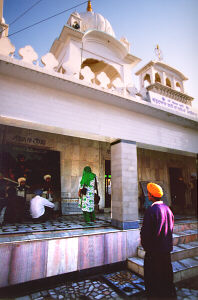
Rest for a Night
Gurdwara Katana Sahib, Dist. Ludhiana
Guru Gobind Singh spent a night here on his way to Alamgir with Muslim brothers Ghani Khan and Nabi Khan. During colonial rule the British had to divert their irrigation canal around the Gurdwara because of its religious sanctity.

A Fond Farewell
Gurdwara Alamgir, Dist. Ludhiana
After traveling through the enemy lines dressed as a Muslim saint with Muslim brothers Ghani Khan and Nabi Khan as his guides Guru Gobind Singh reached Alamgir village. Here Guru Gobind Singh was presented with a horse by a devoted Sikh he met. Guru Gobind Singh discarded his disguise and blessed Ghani Khan and Nabi Khan for their help before bidding them a fond farewell.
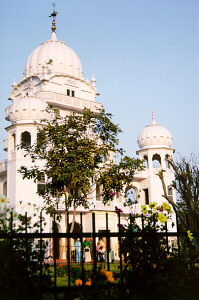
A Special Tree
Gurdwara Phalahi Sahib, Dist. Ludhiana
Guru Gobind Singh stopped here after leaving Muslim brothers Ghani Khan and Nabi Khan at Alamgir a few miles away. The Guru tied his horse with a small Phalahi tree which still stands today.
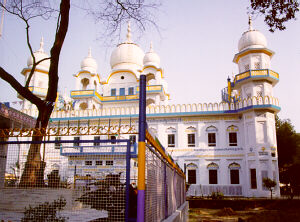
News of the Family
Gurdwara Raikot, Dist. Ludhiana
After leaving Muslim brothers Ghani Khan and Nabi Khan Guru Gobind Singh was received warmly by a wealthy landlord and devotee Rai Kalha. Here at Raikot Guru Gobind Singh stayed in hiding for a number of days. Guru Gobind Singh requested Rai Khala to send a messenger to Sirhind to find out about the whereabouts of his family which had been separated from him during their crossing of the river Sarsa. Rai Kalha reported the tragic story of the execution and martyrdom of the Gurus two younger sons and how his mother Mata Gujri had also passed away. Guru Gobind Singh exclaimed that his sons were the gift of Almighty God and had gone back to Him.
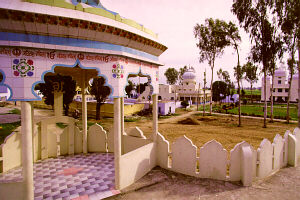
Supreme Sacrifice
Gurdwara Fatehgarh Sahib, Sirhind, Dist. Patiala
The two youngest sons of Guru Gobind Singh, Baba Zorawar Singh and Baba Fateh Singh were martyred at this spot on December 27, 1704. They along with the Gurus mother Mata Gujri had been captured by the governor of Sirhind Wazir Khan. Even though Islamic law does not allow for the killing of children, Wazir Khan gave the two young brothers a choice of either converting to Islam or being put to death. Both sons were bricked up in a wall and had their heads cut off but they steadfastly refused to convert to Islam. Guru Gobind Singhs mother Mata Gujri who had also been captured died from the shock of the murder of her beloved grandchildren. Five years later Banda Singh Bahadur and the Sikh army would take their revenge by destroying the town of Sirhind and killing Wazir Khan in battle.
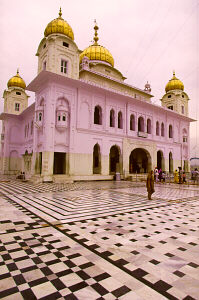
A Letter of Defiance
Gurdwara Zafarnama, Dist. Bathinda
Guru Gobind Singh stayed here for a few days and wrote his famous defiant letter known as the Zafarnama (The Letter of Victory) in Persian to Mughal Emperor Aurangzeb at of the darkest times of his life. Most of the Sikhs had been scattered or killed including the Gurus four sons. In the letter Guru Gobind Singh starts by praising God and then goes on to condemn Aurangzeb for his failure as a ruler, for his communalism and for breaking his oath on the Koran to grant the Sikhs safe passage. Guru Gobind Singh wrote that when all peaceful means have failed, it is righteous to draw the sword to fight tyranny. The Guru describes the bloody battle of Chamkaur and invites Aurangzeb to visit him even though he has killed his four sons. The letter was personally delivered to the emperor in the Deccan by the Gurus two trusted Sikhs Bhai Daya Singh and Bhai Dharam Singh. Upon reading the letter the emperor was filled with remorse and asked Guru Gobind Singh to come visit him, but Aurangzeb died shortly thereafter in 1707.
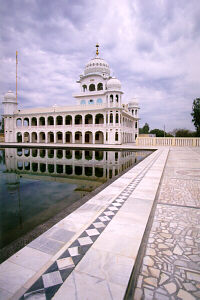
Blessed by God
Gurdwara Gangsar, Jaito, Dist. Faridkot
Guru Gobind visited here on his way to Muksar. The Guru met a Hindu pilgrim who was on his way to the sacred Ganges river for a dip. Guru Gobind Singh convinced the pilgrim that a dip in the pool at Jaito was just as equivalent as bathing in the Ganges as all places are sacred and blessed by God.
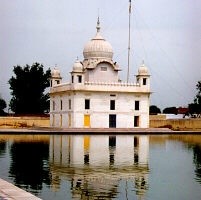
The Last Battle
Gurdwara Tibbi Sahib, Muktsar, Dist. Faridkot
This was the scene of Guru Gobind Singhs last battle, the battle of Khidrana fought on December 29th 1705. A large force of the enemy Mughal troops of Wazir Khan were seen approaching on the horizon. A village women Mai Bhago had gathered together 40 Sikhs who had earlier deserted Guru Gobind Singh at Anandpur Sahib and they were camped between the Guru and his men in the forest and the approaching enemy in the dry plains. Guru Gobind Singh and his accompanying Sikhs took up a position on top of a sand hill at this spot and showered arrows on the approaching enemy.
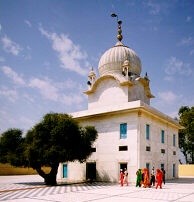
40 Immortals
Gurdwara Thambu Mal & Darbar Sahib, Muktsar, Dist. Faridkot
As the enemy troops of Wazir Khan were approaching Guru Gobind Singh they were intercepted by a force of 40 Sikhs led by a village women Mai Bhago. Earlier during the prolonged siege of Anandpur Sahib, 40 Sikhs had deserted the Guru by signing a letter saying that they were no longer Sikhs of the Guru. They lived in the Malwa region in which Guru Gobind Singh was now staying. Here they were shamed by their women folk for having deserted the Guru. Mai Bhago dressed in soldiers uniform gathered the 40 deserters to help Guru Gobind Singh and they engaged the approaching army of Wazir Khan at this spot. While the enemy had a large force they was tired from their long march while the outnumbered Sikhs were fresh. In the fierce battle the ensued the Sikhs were able to scatter the enemy who were forced to retreat after having suffered severe casualties and because of the lack of drinking water in the area. Although the Sikhs emerged victorious, all 40 former deserters were killed in battle. Guru Gobind Singh was deeply touched by the sacrifice of the 40. As Guru Gobind Singh surveyed the battle scene, one seriously wounded Sikh Mahan Singh was still alive and before he died he begged Guru Gobind Singh to forgive the 40 for having deserted him earlier. Guru Gobind Singh blessed the 40 and said that they had achieved 'Mukhti', spiritual liberation for their brave act of self sacrifice.
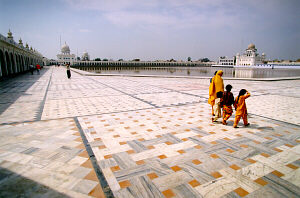
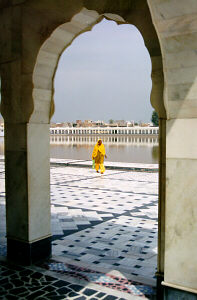
Daily Prayers
Gurdwara Shahid Ganj, Muktsar, Dist. Faridkot
The Chalis Mukte (40 Immortals) were personally cremated here by Guru Gobind Singh who performed their last rites and blessed them. They are remembered for their sacrifice every day in the Sikh daily prayer, Ardas.
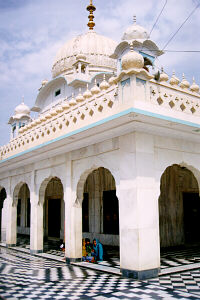
Ghosts and Superstitions
Gurdwara Haji Rattan, Dist. Bathinda
While on his way to Talwandi Sabo Guru Gobind Singh camped here for the night outside the mausoleum of the Muslim saint Haji Rattan. The tomb keepers tried to dissuade the Guru from sleeping here with the excuse that the place was haunted. Since the Guru neither believed in tombs or ghosts he spent the night here to show the people that such superstitions were not followed by Sikhs.
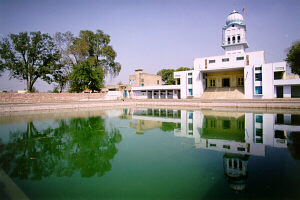
The Next Guru
Takht Sri Damdama Sahib, Talwandi Sabo, Dist. Bathinda
Guru Gobind Singh stayed here for almost a year during 1705 to 1706 after his last battle at Muksar. It was here that Guru Gobind Singh with the help of his scribe Bhai Mani Singh prepared the final and current version of Sri Guru Granth Sahib. Guru Gobind Singh added to the existing version prepared by Guru Arjan the poetry of Guru Tegh Bahadur. Due to his great humility Guru Gobind Singh did not include any of his own poetry in Sri Guru Granth Sahib.
